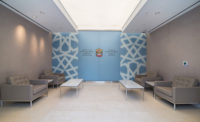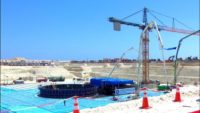

Predicting energy demand to grow 9% annually, the United Arab Emirates announced last month that it has started construction on the country's first nuclear powerplant after receiving design and building approval for the first of four planned units. Each unit is set to provide 1,400 MW.
The Emirates Nuclear Energy Corp. (ENEC), an entity created in 2008 to oversee development of the Barakah Nuclear Facility to meet U.A.E. power needs and those of its Gulf neighbors, said in a statement the project was valued at an estimated $20 billion.
U.A.E. is believed to be the first country since China, more than 31 years ago, to authorize a new nuclear-power construction program. Concrete now is being poured for the Barakah Unit 1, located in the industrial town of Al Ruwais, near the Persian Gulf in Abu Dhabi.
The U.A.E.'s Federal Authority for Nuclear Regulation granted the license for the first two units in a process that took four years and resulted in a 9,000-page application that included issues related to site selection, technology, safety and quality control, and the construction process. ENEC says it responded to more than 1,800 requests for information from the agency.
ENEC says it will apply for an operating license for Unit 1 in 2015 and will pour concrete for Unit 2 in 2013. The first unit is set to come on line in 2017 and the rest in one-year intervals by 2020, according to the company's statement.
Authority Director General William Travers, who is a former operations executive director at the U.S. Nuclear Regulatory Commission, said in a published report that all the specific characteristics of the site have been assessed and that the agency's approval represents at least a "preliminary approval of the design that's been proposed."
He also said the review included issues raised following the tsunami-related accident in March 2011 at Japan's Fukushima nuclear plant.
ENEC's design-build consortium for the plants is headed by Korea Electric Power Co. (KEPCO), which will use the APR-1400 PWR design technology evolved from the U.S. model. KEPCO will provide "full scope of works and services," including engineering, procurement, construction, nuclear fuel, and operations and maintenance support, says ENEC.
The almost all-Korean team also includes Korea Hydro and Nuclear Power Co. Ltd. as engineering, procurement and construction (EPC) contractor and nuclear-plant operator. Korea Power Engineering Co. Inc. will conduct plant design and engineering services, and Korea Nuclear Fuel Co. Ltd. will provide enriched-uranium nuclear fuel.
Others in the consortium include Doosan Heavy Industries, Hyundai Engineering & Construction, Samsung C&T Corp. and Westinghouse.
The Generation III Westinghouse design is intended to ensure the plant can withstand extreme events including tsunamis, earthquakes and station blackouts, says KEPCO. Doosan Heavy Industries will supply major components for all four reactors. A limited license from the U.A.E. will enable the firm to manufacture and assemble nuclear-safety-related equipment, including the reactor's pressure vessel, steam generators, pressurizers and coolant pumps. Manufacturing is set to start this year.
ENEC says it has poured more than 1,500 cubic meters of concrete to form a portion of the foundation slab of Unit 1's reactor containment building.
The next phase of construction will include continued pouring of concrete for that structure as well as for an auxiliary building, turbine building and cooling-water structures. Liner-plate on-site fabrication and installation at the containment building using heavy lift cranes will start by the end of 2012, according to ENEC.
Barakah was selected from 10 sites, mainly for its low probability of earthquakes. The Gulf seawater at Barakah is about 35° C, so larger heat exchangers and condensers will be required, says ENEC.
CH2M Hill, Denver, is ENEC's program manager for the nuclear projects.





